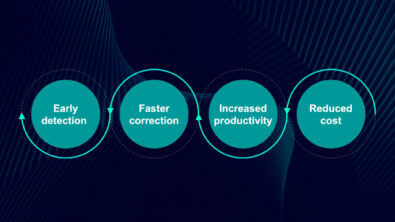That cloud looks like…a successful IC tapeout!
By Omar El-Sewefy – Mentor, A Siemens Business
Running Calibre software in the cloud can help companies quickly adjust resource usage to fit their business requirements and market demands. Here’s how it’s done…
Cloud services are everywhere these days, and the reasons tend to be pretty self-evident. You can use software in a cloud without having to install it on your hardware, or have instant access to computing resources that would take you months to years to acquire and install. With the cloud, you only pay for what you use, so it’s a quick, convenient way to scale your resource use up and down as your business needs change, while also lowering your operating costs (no hardware maintenance!). Clouds come in all forms, from enterprise clouds (for a single company) to public clouds (available to pretty much anyone), and all sorts of hybrid clouds that combine different aspects of both.
EDA came a little late to the cloud party, mostly over concerns about the protection and control of intellectual property (IP) and highly proprietary data like process design kits (PDKs). The good news is that cloud providers implemented expanded security measures that addressed these concerns, making cloud EDA a safe and practical option. The most common form of cloud computing in EDA is the platform as a service (PaaS) model, in which EDA companies enable their customers to develop and run their PDKs on a cloud platform.
The even better news? Running EDA tools on the cloud doesn’t require any special processes or equipment. Any EDA software you can run locally can be installed and run on the cloud. The only effort required to perform physical verification in the cloud is solely in the cloud setup itself— choosing the cloud provider and setting up the cloud environment. But why move to a cloud environment?
Most companies do it for one of two reasons.
- From a cost perspective, they avoid the capital investment of buying more servers, as well as the ongoing cost of maintenance. If your company regularly experiences high demand periods in which multiple users need to access limited resources, the cloud can provide easy, seamless transitions between those low and high demand intervals.
- From a performance perspective, the amount of computing required for today’s IC designs makes it challenging, if not impossible, for most companies to support the amount of computing resources needed to maintain fast verification runtimes. With the cloud, you can leverage the Calibre platform’s inherent scaling capability by acquiring instant access to the resources needed to meet your turnaround time targets.
Of course, we understand that cloud resources aren’t free. To ensure Calibre users can employ cloud resources in the most cost-efficient manner, we recommend certain usage guidelines and suggest best practices. Mentor worked closely with foundries, design companies, and cloud service providers to develop these guidelines and ensure a smooth transition from on-site grid systems to off-site cloud processing. If you’d like to learn more, download a copy of our white paper, Calibre in the cloud: Unlocking massive scaling and cost efficiencies.



